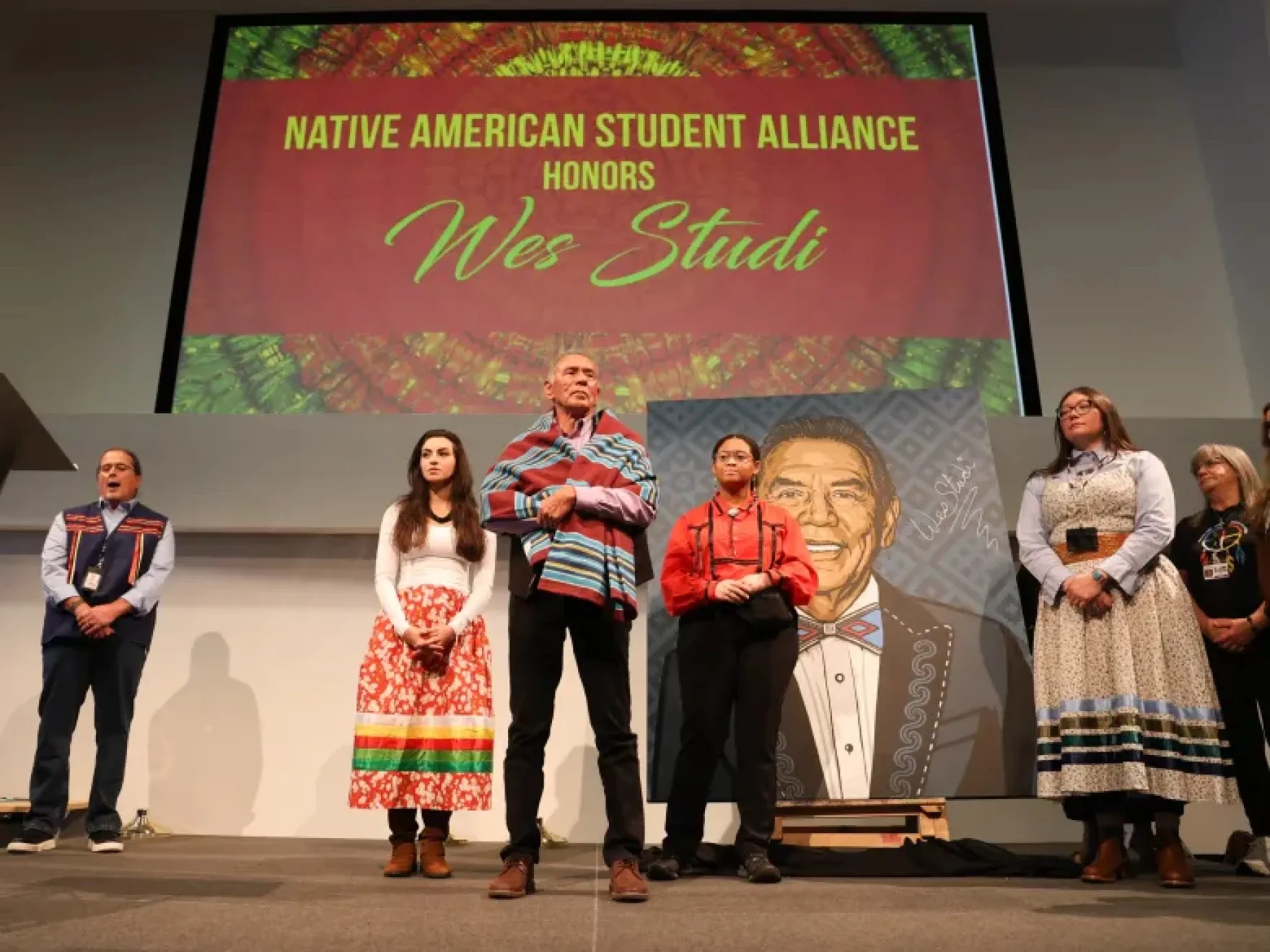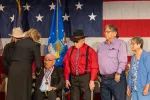

Tribes File Federal Suit Over Prosecution of Hunting and Fishing on Tribal Land



Chickasaw Nation, Choctaw Nation of Oklahoma and Cherokee Nation defend tradition, sovereignty and treaty rights for members and citizens
TULSA, Okla. – Chickasaw Nation, Choctaw Nation of Oklahoma and Cherokee Nation filed a federal lawsuit in United States District Court for the Northern District of Oklahoma naming Oklahoma Gov. Kevin Stitt; his recently appointed special prosecutor, Russ Cochran; and the Oklahoma Department of Wildlife Conservation as defendants.
The lawsuit argues that Gov. Stitt lacks the authority to appoint a special prosecutor for wildlife crimes on tribal land. It also claims his directives to ODWC violate tribal sovereignty and jurisdiction, as affirmed by the Supreme Court’s 2020 McGirt ruling.
Leaders from the state's three largest tribes reacted to the continued unlawful citation of Indigenous hunters on tribal land.
“The Choctaw Nation will defend its rights and those of its members against the Governor’s unlawful prosecution, as hunting and fishing are deeply rooted in our sovereignty and the traditions of the Choctaw people long before this state was founded,” said Choctaw Nation Chief Gary Batton. “Gov. Stitt’s attack of our members is causing harm and distress, and we won’t let this overreach continue. We remain committed to conserving, protecting and enhancing wildlife resources, including our continued strong working relationship with ODWC.”
“We are proud to stand today with our fellow sister nations in defense of tribal sovereignty, which protects our Native citizens on tribal land,” said Cherokee Nation Principal Chief Chuck Hoskin, Jr. “By targeting hunters and fishers legally exercising their treaty rights, against the advice of the Oklahoma attorney general, Governor Stitt is once again showing Oklahomans he cares more about attacking tribal sovereignty than helping the state. The governor, as he did when he terminated our long-standing wildlife compacts, continues to reject a path of cooperation, and force a path of litigation. We appreciate the work of Attorney General Drummond and other partners throughout the state who respect tribal rights and Oklahoma values, and we will continue to defend our traditions and the rights of our people in federal court."
“Our primary aim is to protect the rights of our people to fish and hunt, as protected by treaty and federal law,” said Chickasaw Nation Governor Bill Anoatubby. “Our treaties are among the supreme law of the land. Our citizens are good people acting in good faith. They are acting in compliance with federal and tribal law and with respect for Oklahomans’ private property rights. We stand ready to work with our friends in the state of Oklahoma to ensure accurate reporting of data and to facilitate safe and enjoyable hunting and fishing for all Oklahomans.”

Muscogee Nation Approves $185Million for state-of-the-art health facilities

OKMULGEE, OK — In a landmark move to continue the progressive expansion of healthcare services for Muscogee citizens, the Muscogee Nation National Council has approved a $185 million financing package to support the construction of two transformational health facilities — a new comprehensive clinic in Holdenville and an expanded replacement clinic in Sapulpa.
“This investment underscores the Nation’s long-term commitment to accessible, high-quality, and culturally competent healthcare. Our people deserve the very best healthcare we can provide — in settings that reflect our values and meet their needs,” said Principal Chief David W. Hill.
“As a Nation we have committed to an aggressive and expansive strategy to meet the healthcare needs of our citizens and communities. The National Council is humbled to approve this historic financing package to ensure that we are honoring our promises to the people,” said National Council Speaker Randall Hicks.
The Holdenville campus will span more than 67,000 square feet across 40 acres, designed not only as a healthcare facility but as a collective hub for prevention, wellness, and community health. The clinic will offer a full range of services—including primary care, dental, and optometry—while integrating outdoor wellness spaces that encourage long-term healthy living.
“This is more than a building. It’s a promise to our citizens that we will continue to invest in their health — not just for today, but for generations to come,” said Secretary of Health Shawn Terry. “This campus in Holdenville is about community, prevention, and providing care that meets our people where they are.”
In Sapulpa, the current clinic will be replaced with a two-story, 148,000-square-foot facility, more than ten times the size of the existing center. This modern clinic will bring a comprehensive suite of services under one roof, including primary care, pediatrics, women’s health, pharmacy, dental, optometry, and a range of specialty clinics. The Sapulpa facility is also designed to foster collaboration among healthcare professionals, strengthening care coordination, improving patient outcomes, and enhancing the overall patient experience.
The financing package — led by BOK Financial — represents one of the largest health-related investments in the Nation’s history. BOK Financial will lead the syndication process, incorporating a network of local lending institutions to ensure the economic benefits of the project extend throughout the region.
“We are proud to partner with BOK Financial and other local lenders who understand the importance of tribal infrastructure and support our mission to uplift the health and wellness of our people,” said Secretary Terry.
“These are incredibly impactful projects, and we’re honored to be a trusted partner of the Muscogee Nation,” said Sarah Alexander of BOK Financial.
Groundbreaking ceremonies for both facilities are scheduled to take place in the coming months. Together, these projects mark a new chapter in the Nation’s healthcare journey — one that blends cutting-edge medical services with cultural, community-centered design to serve future generations of Muscogee citizens.

Tulsa Community College students honor alum Wes Studi for elevating Indigenous voices in film, beyond

Four decades after launching his acting career in Tulsa, Oscar winner Wes Studi returned Thursday to be honored by Tulsa Community College students for his groundbreaking career that has elevated Indigenous voices in film and beyond.
TCC’s Native American Student Alliance hosted the event inside Thomas K. McKeon Center for Creativity to celebrate the achievements of the TCC alumnus, who has starred in numerous legendary films, including “Dances With Wolves,” “The Last of the Mohicans,” “Heat” and “Avatar.”
“It was a wonderful place to actually begin to realize what the world was made up of,” Studi said about his time at TCC. “I am so glad that I took the opportunity to use my G.I. Bill to attend classes here, as it was, I like to say, the awakening on a political and societal level that has brought me to where I am today. It was also the beginning of the recognition that I was not only Cherokee, but I was also a Native American, Indigenous or people of this land.”
Studi, a U.S. Army veteran, enrolled in classes in the early 1970s at what was then Tulsa Junior College. While on campus he started a Cherokee newspaper and taught Cherokee language, according to TCC professor Steven Woods, who introduced Studi at Thursday’s event.
It was in that era that Studi joined the American Indian Theater Company to begin his acting career. In 1984, the company’s production of “Black Elk Speaks” at the Tulsa Performing Arts Center starred the late Will Sampson, the late David Carradine, and Studi, whose experiences in that production motivated him to pursue film roles.
After building a successful career in Hollywood, Studi returned to Oklahoma to play a small role in Sterlin Harjo’s “Reservation Dogs” from 2021-2023. Studi returned to the Tulsa stage in 2024 to perform in a production of “Nanyehi” at Hard Rock Hotel and Casino Tulsa.
The student-led event featured the unveiling of a new art installation created by Cherokee artist Bryan Waytula and Nick White, inspired by Studi’s life and legacy. The portrait will hang in TCC’s northeast campus.
Native American Heritage Month: The History of Choctaws in Texas

Haiyowvni Choctaw living among the Caddo in East Texas
This month, Iti Fabvssa would like to focus on the history of Choctaw presence in East Texas from 1790 to 1840. There is little information written on Choctaw people in East Texas now. What little information does exist is from Spanish, Mexican, Texan, and American reports. Many Choctaw people who moved to East Texas were looking for a peaceful way of life where they could continue to live freely, without the pressures of colonization. However, the first Choctaw encounters in the region were not marked by peace, but by violence.
During the French Period, 1699–1763, the Choctaw Nation had established a strong Alliance with France. During this time, Choctaw hunters began participating in the French fur trade, where they would bring hides and materials to French traders in exchange for European manufactured goods. As the French were forced to leave the area, Choctaws continued this trade with Great Britain and Spain.
By the 1770s, deer and other wild game were becoming scarce in our homelands because of overhunting and drought (Caldwell 2020: 6). This caused Choctaw hunters to travel farther west, across the Mississippi River, to hunt in lands that belonged to other tribes. As large Choctaw hunting parties began trespassing onto Caddo hunting lands, conflicts arose.
The Caddo, weakened by disease, could not block Choctaw hunters from invading their lands and raiding their settlements (Caldwell 2020: 8). By 1790, Choctaw hunting parties ranged deeper into Caddo territory, crossing into East Texas and raiding Caddo and Tonkawa villages for horses and cattle to bring back to American traders (Smith 2005: 60; Kinnaird 1980: 351). Conflict would continue between the Choctaw and Caddo throughout the 1790s in Louisiana and East Texas.
Choctaws were also under various pressures: land loss, pressure from settlers, and internal tribal politics. Texas offered a chance for Choctaws to live in smaller, independent communities alongside other tribal groups who were also resisting US control. Not all Choctaws accepted the path laid out by U.S. policy and Choctaw leaders. Texas offered an alternative.
The Haiyowvni, or cutworm in the Choctaw language, was a group of Choctaw who lived in the southern district of the Choctaw Nation. Their home was the closest village to French Mobile and in the 1720s had a Jesuit Missionary living in the village as well as a French trading post. We do not know why, but in 1763, a large group of Haiyowvni left Mississippi and traveled to the north shore of Lake Pontchartrain in Louisiana where they lived alongside emigrating bands of Biloxi and Alabama peoples (Smith 2005: 20).
Soon after, they moved west to Bayou Bouef, southwest of what is today, Natchitoches, LA. It is possible that they moved due to the 1765 Treaty of Mobile, where Great Britian deceptively tricked the Choctaw Nation into ceding its lands stretching along the gulf coast from Mobile, across the north shore of Lake Pontchartrain to the Mississippi River. On Bayou Bouef, the Haiyowvni planted crops and raised livestock for roughly three decades (Smith 2005: 20).
In 1797, the pressure from American settlers would force the Haiyowvni on Bayou Bouef to sell 2,600 acres of land on both sides of the bayou for $200 in goods (Smith 2005:64). Meanwhile, the Fulton and Miller trading company opened its doors to the Native people living on Bayou Bouef.
Over the next few years, the Haiyowvni and others began to incur debts. In 1802, the Fulton and Miller Company forced the Haiyowvni to sell the remainder of their lands, totaling 41,284 acres for $3,724 (Smith 2005: 64-65). Now forced to leave their homes, they traveled westward toward a prairie where they reestablished their village, planted fields, built fences, and began raising livestock again (Smith 2005: 65). In 1803 the United States gained control of Louisiana. Groups of Apalaches, Taensas, Alabamas, Coushattas, Haiyowvni Choctaws, Pascagoulas, and Biloxi’s began to immigrate to East Texas to keep out of reach of the American settlers (Smith 2005: 67).
In 1804, a group of 200 Haiyowvni Choctaws established two to three small villages between the Trinity and Neches Rivers (Smith 2005: 69). Soon after, the Spanish granted the Choctaws and other emigrating groups permission to continue to live in their new villages. As more Choctaws moved to Louisiana, additional villages were settled along the Neches, Angelina, and Attoyac Rivers in East Texas.
By 1820, large groups of Cherokee, Choctaws, Shawnee, Delaware, Kickapoo, Quapaw, Biloxi, Iowa, Tohookatokie, Alabama and Coushatta had settled about forty miles north of Nacogdoches, TX (Hale 1987: 9). In 1821, Mexico had won its war for independence from Spain and sought to build relationships with the Tribes in East Texas. After meeting the Choctaw people, Mexican Diplomat Juan N. Almont was impressed and wrote a letter stating that the Choctaw would be desirable citizens of Mexico (Caldwell 2020: 17).
Back in Mississippi and Alabama, the Choctaw Nation was forced to sign the Treaty of Dancing Rabbit Creek in 1830. One year later, the Choctaw removal in our homelands would begin. More than 700 Choctaw people migrated to Texas instead of coming to Indian Territory. They would join ten to fifteen other families who had previously migrated before 1830 (Carlisle 2021). These groups would settle in large communities near the modern Texas towns of Patroon, Center, Enterprise.
In 1835, Sam Houston helped negotiate a treaty with the East Texas Tribes, including the Choctaw, to ensure their neutrality during the Texas Revolution. The Choctaw were signatories of the 1836 Treaty of Bowles Village with the Republic of Texas. However, the next year, the newly created Republic of Texas did not ratify the Treaty. Despite President Sam Houston’s work to create peace with the East Texas Tribes, issues between the Tribes and Texas settlers caused tension.
In 1838, the second President of the Republic of Texas, Mirabeau Lamar, considered the Tribes of East Texas to be intruders and wished to remove them onto reservations in Texas or force them out of Texas into Indian Territory. The next year, he sent a regiment of 500 Texan troops to negotiate removing the East Texas Tribes. After two days of negotiations, the Texan commissioners informed the tribal delegates that the Republic of Texas would not wait any longer and that they would begin marching on the Cherokee Village where the negotiations were taking place. The Cherokee and the tribal delegation retreated north to a Delaware village hoping to continue negotiations with the Texans, however the next day the Delaware village was attacked.
Over 400 Cherokee, Shawnee, Delaware, and an unknown number of Choctaw and other Tribal warriors fought for two hours. They sacrificed themselves so their families could gain a head start retreating toward the Red River, with the hopes of crossing into the Choctaw Nation. After two hours of fighting, over 100 tribal warriors had died. The Cherokee Chief Duwali was the last warrior standing on the battlefield (Smith 2005:172). He died on the battlefield holding his sword, a gift from Sam Houston, the first President of the Republic of Texas. This massacre would be known as the Battle of the Neches.
Many Choctaws and Haiyowvni Choctaws settled in the Choctaw and Chickasaw Nations after their retreat from Texas. Other Haiyowvni Choctaws moved with the Caddo to the Brazos Reserve in 1854. In 1859 they would move with the Caddo again to Indian Territory and become part of the Caddo Nation. Other Haiyowvni Choctaw joined the Alabama and Coushatta in East Texas and are now part of the Alabama-Coushatta Tribe of Texas.
The legacy of these events continues to echo through the oral stories of Choctaw families today.
“My grandfather was given the middle name Lamar after his birth in Paris, Texas. My Father was also given the middle name Lamar when he was born and when I was born the name was also given to me. I have always cherished this gift, but the irony of the name Lamar is not lost to me. My grandfather was possible given the name because he was born in Lamar County, Texas, a county named after President Lamar who ordered the expulsion of my Haiyowavni Choctaw family from Texas and resulted in the death of 5th great grandfather, Chief Atahobia, at the Battle of the Neches (personal communication, Ryan Lamar Spring, 2025).
Remembering familial stories such as this reflects the enduring influence of Texas’s early history on the generations that followed. These Texas Choctaw Communities’ experiences are an example of the strategies that Native communities used to navigate and resist colonial expansion and stand as a testament to the strength and identities of Choctaw people today.
Works Cited
- Caldwell Jr., Robert B. 2020 Choctaw Frontier: Incursions and Settlement in Northwest Louisiana and East Texas, 1760-1836. North Louisiana History 51(3-4):1-35
- Carlisle, Jeffery D. 2021 Choctaw Indians, Handbook of Texas Online, accessed May 25, 2021. Published by the Texas State Historical Society.
- Hale. Duane Kendall 1987 Peacemakers on the Frontier: A History of the Delaware Tribe of Western Oklahoma. Delaware Tribe of Western Oklahoma Press, Anadarko.
- Kinnaird, Lawrence and Lucia B. Kinnaird 1980 Choctaws West of the Mississippi, 1766-1800. The Southwestern Historical Quarterly 83(4):349-370
- Smith, F. Todd 2005 From Dominance to Disappearance: The Indians of Texas and the Near Southeast, 1786-1859. University of Nebraska Press, Lincoln and London.








